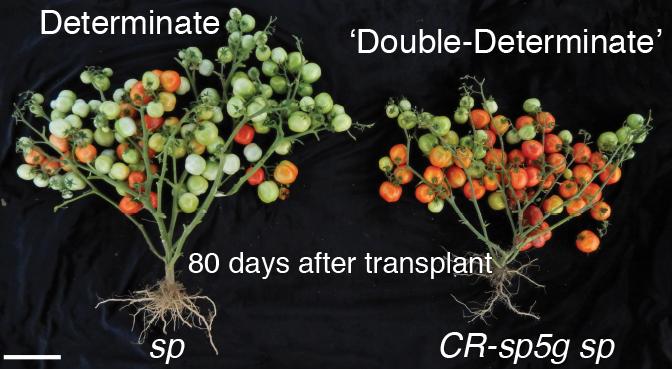



Business Inquiry
Global:
Email:marketing@medicilon.com
+1(781)535-1428(U.S.)
0044 7790 816 954 (Europe)
China:
Email: marketing@medicilon.com.cn
Tel: +86 (21) 5859-1500



Scientists working on the much-maligned genetically modified organisms (GMOs) have a new molecular tool at their disposal to tweak the genomes of various plants, in order to improve harvest yields and expand the geographical range of important food crops. Research led by investigators at Cold Spring Harbor Laboratory (CSHL) has formulated a rapid method to make two popular varieties of tomato plants flower and produce ripe fruit more than 2 weeks faster than commercial breeders are currently able to do.

The impact of this discovery cannot be overstated, as the potential impact could mean more plantings per growing season and thus higher yield. Moreover, it also means that the plant can be grown in latitudes more northerly than currently possible. Attributes that are extremely important as the earth’s climate warms and population continue to burgeon.
“Our work is a compelling demonstration of the power of gene editing—CRISPR [clustered regularly interspaced short palindromic repeats] technology—to rapidly improve yield traits in crop breeding,” noted senior study investigator Zachary Lippman, Ph.D., associate professor at the Watson School of Biological Sciences within CSHL. “It’s really about creating a genetic toolkit that enables growers and breeders in a single generation to tweak the timing of flower production and thus yield, to help adapt our best varieties to grow in parts of the world where they don’t currently thrive.”
In addition to advancing crop yields, the researchers obtained valuable insights into the evolution of the flowering process in many crops and their wild relatives, as it relates to the length of the light period in a day. Genetic research revealed why today’s cultivated tomato plant is not very sensitive to this variable compared to wild relatives from South America. Somehow, it does not much matter to domesticated plants whether they have 12 hours of daylight or 16 hours—they flower at virtually the same point after planting.
Previous work has described a hormonal system that regulates flowering time and the time when the plant will generate its first ripe fruit. The hormone florigen and a counteracting hormone called SP (for SELF-PRUNING) function as a duo to either promote or delay flowering. In this new research, the investigators studied a wild tomato species native to the Galapagos Islands—near the equator, with days and nights close to 12 hours year-round. They wanted to learn why, when grown in northern latitudes with very long summer days, this plant flowered very late in the season and produced few fruits.
The scientists quickly learned that the wild equatorial tomato was extremely sensitive to daylight length. The longer the day, the longer the time to flowering, whereas shorter light periods, as in the plant’s native habitat, cause the tomato plants to flower faster. This finding suggested there was a genetic change in tomato plants that occurred at some point before or during the domestication of wild tomato plants.
Dr. Lippman and his colleagues traced the loss of day-length sensitivity in domesticated tomatoes to mutations in a gene called SP5G (SELF-PRUNING 5G). It’s a member of the same family of florigen and antiflorigen genes that were already known to regulate flowering time in tomato.
Growing wild tomato plants from the Galapagos in greenhouses and fields in New York, the investigators observed a sharp spike in the expression and activity of the antiflorigen hormone encoded by the SP5G gene, causing flowering to occur much later. Conversely, in domesticated tomato plants the surge of antiflorigen is much weaker.
The findings from this study were published recently in Nature Genetics in an article entitled “Variation in the Flowering Gene SELF-PRUNING 5G Promotes Day-Neutrality and Early Yield in Tomato.”
In the current study, the CSHL researchers generated varieties of cherry and Roma tomatoes that flowered much earlier than the domesticated varieties on which they are based—arising from the observation that while domesticated plants are notably insensitive to day length, “there was some residual expression of the antiflorigen SP5G gene,” Dr. Lippman said.
This led the team to employ the gene-editing tool CRISPR to induce tiny mutations in the SP5G gene. The aim was to inactivate the gene entirely such that it did not generate any antiflorigen protein at all. When this tweaked version of SP5G was introduced into the Roma and cherry tomato varieties, the plants flowered earlier and thus made fruits that ripened earlier. Tweaking another antiflorigen gene that makes tomato plants grow in a dense, compact, shrub-like manner made the early-flowering varieties even more compact and early-yielding—a trait the team calls “double-determinate.”
“What we’ve demonstrated here is fast-forward breeding,” Dr. Lippman remarked. “Now we have a simple strategy to completely eliminate daylight sensitivity in elite inbred and hybrid plants that are already being cultivated. This could enable growers to expand their geographical range of cultivation, simply by using CRISPR to rapidly ‘adapt’ tomato and other crops to more northern latitudes, where summers have very long days and very short growing seasons.”
 Relevant
news
Relevant
news